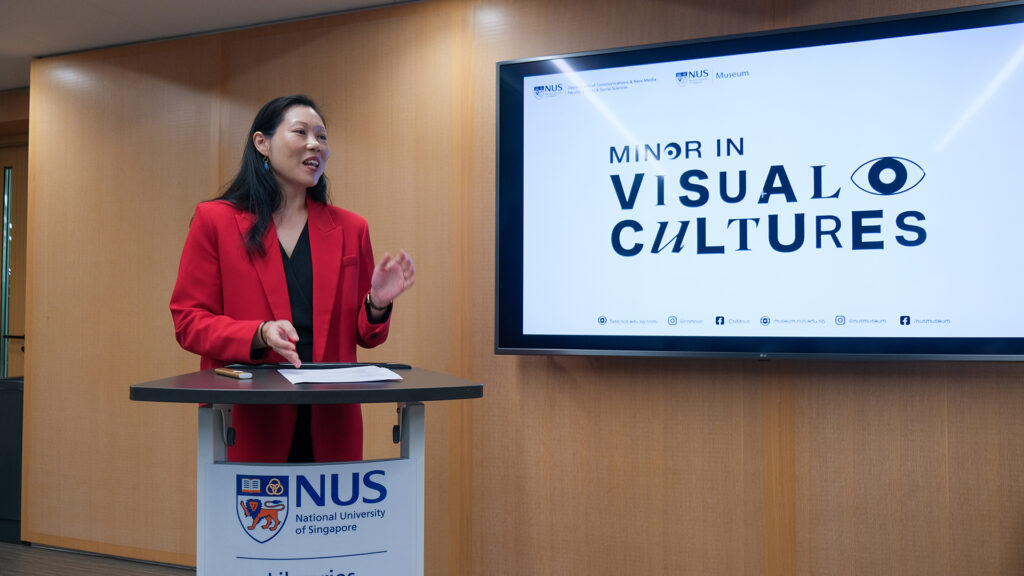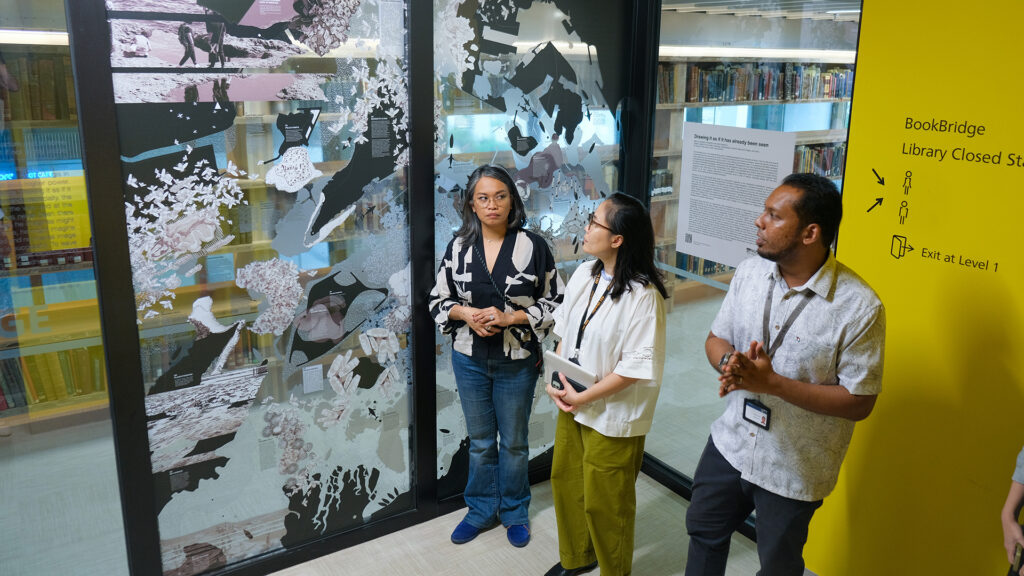NUS Minor in Visual Cultures explores the power and cultural impact of visual imagery in our lives
October 18, 2024
IN BRIEF | 10 min read
- The new interdisciplinary and versatile programme – a first among universities in Singapore – delves into how visuals reflect and influence identity, politics and economics, encouraging broad critical thinking across the humanities and scientific fields.

How many images do we see in a day? Scrolling through social media platforms or news sites on our way to school or work, we may have already seen a few hundred images, from memes and photographs to advertisements, posters and videos or animated content.
These visual imageries not only affect our mood, how we think and perceive or relate to other content, but have the power to shape narratives and societies and cultures. In short, visual media impact and shape our lives in ways we may not immediately recognise.
Students examined these illuminating insights during a workshop on 9 October that introduced the basic concepts of visual cultures and curatorial practices. The workshop was an introduction to the Minor in Visual Cultures that will soon be available to all undergraduates at NUS.

NUS first to offer Visual Cultures as a minor across the STEM and humanities fields
When launched in January 2025, NUS will be the first university in Singapore to offer students the option of pursuing a Minor in Visual Cultures. The programme, jointly offered by the Department of Communications and New Media (CNM) at the NUS Faculty of Arts and Social Sciences and NUS Museum, will equip students with skills to understand, critique and ethically use visually-driven media and artefacts in and across the STEM and humanities disciplines of design, digital technology, communications and new media, architecture, visual arts, aesthetics, and culture.
This is the first time NUS Museum, a university museum that houses Asian art and cultural collections and facilitates intellectual and culture life at the university, has co-developed and will co-teach a Capstone course in an undergraduate programme.
“Visual culture is everywhere. The visual tells us a lot about how we live, how we think. Visuality influences our choices, our political views, and our ways of being,” said Programme Director of the Minor in Visual Cultures, Associate Professor Lilian Chee from the Department of Architecture (DoA) at the College of Design and Engineering at NUS (CDE). Assoc Prof Chee is also Academic Director of the NUS Museum and holds a joint appointment at CNM. She adds, “In such a visually saturated world, visual literacy is particularly important for understanding the production, consumption and interpretation of information. It is a hugely valuable skill for any field of study, and in any future professional role.”
Assoc Prof Chee emphasised that being multi- and interdisciplinary in nature, the Minor in Visual Cultures strongly aligns with NUS’ goal of developing critical thought leaders with multimodal skills to think, act and communicate effectively across disciplines.
Registration for the Minor in Visual Cultures will open in mid-December 2024. To be certified with the Minor, students enrolled in the programme must take and pass two compulsory core courses and three electives.
This includes the introductory and compulsory course ‘Reading Visual Images’ offered by DoA which introduces students to ways of interpreting and discussing works of art, specifically through paintings and sculpture.
Electives-wise, students can choose from 27 courses drawn from 11 departments and divisions in the Humanities or Sciences such as ‘AI for Design’, “Cartography and Geovisualisation’, ‘Modern Art: A Critical Introduction’, ‘Social Psychology of New Media’ and ‘Modern Optics’.
Ms Siddharta Perez, Museum Curatorial Lead at NUS Museum added, “Collaborating with CNM on the Minor in Visual Cultures allows the Museum to impart their industry knowledge and insights to students through hands-on exhibition-making or multidisciplinary research centred on visual cultures. It also draws on the Museum’s rich collections of visual resources, objects and archives on Singapore and the region.”
A “Visual Cultures” Capstone course

The programme culminates in a compulsory “Visual Cultures” Capstone course that examines the significance of the visual and the politics of visuality across the fields of heritage, environmental humanities, philosophy, spatial practices, design, architecture, visual art and performance.
The course will first bring together knowledge gleaned from the theoretical electives. A consolidation of different types of visual categories (such as objects and paintings, buildings, maps, social media, photographs and AI-generated images), it gathers key visual theories from different disciplines (film studies, architecture, communications and media, geography, history, and philosophy among them) to discuss, examine, and reflect on their relationships.
In the second half of the course, students will be required to develop projects to demonstrate critical visual cultural thinking and skills. These projects may take on more experimental pathways, involve novel interventions in existing exhibitions, develop a series of public programmes or marketing campaigns or work on expanding or enhancing the Museum’s current collections.
Such project-based and problem-based learning will provide students opportunities to launch a media campaign, pitch an idea for funding, strategise the gathering of resources and their allocation, learn how to use social media ethically, and how to market content through visual media.
Dr Baey Shi Chen, a lecturer with the Department of CNM and Co-convener of the Minor in Visual Cultures shared, “The Capstone course offers a broad-based education, focusing primarily on how the visual both gathers and cuts across a wide range of disciplines. Students will strategise how to collect and curate visual information, and learn how audiences perceive the work. These are transferable skills that can translate across a broad range of professions: from the arts to hospitality, banking, education, media and design, healthcare, science and law.”
Neo Jie Ning, a third-year student with the NUS Yong Siew Toh Conservatory of Music, who attended the workshop to learn more about the Minor in Visual Cultures shared that she was particularly intrigued by the diverse range of courses offered by the Minor. “As someone passionate about photography and visual arts, I believe taking these courses will not only deepen my understanding of visual arts but also offer fresh perspectives that complement my current major in Music and Production.”
Students who are keen to learn more about the field can find out more about upcoming workshops that will take place on 23 October and 6 November here.
This story first appeared on NUSnews on 17 October 2024.

